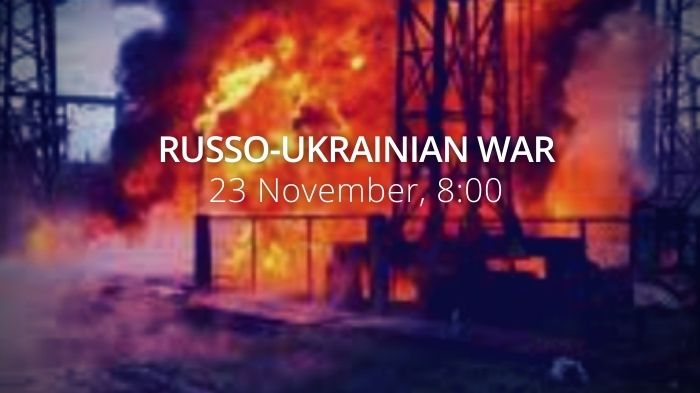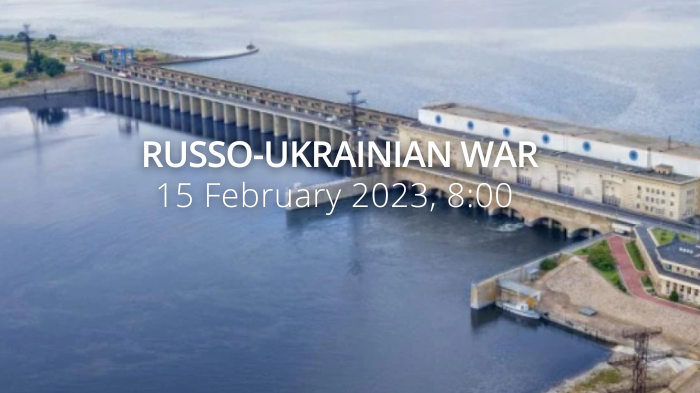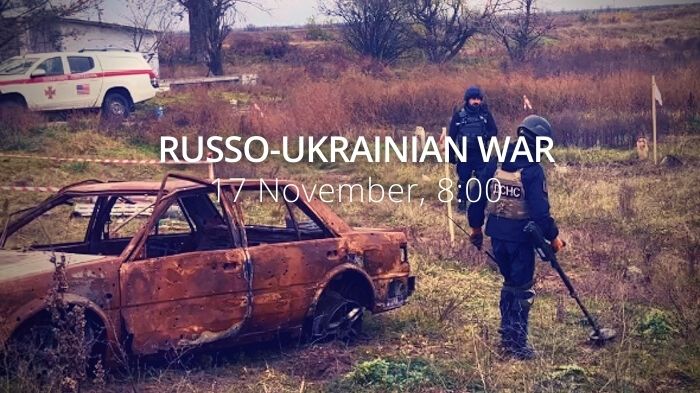The Russian Federation is actively transferring equipment to the Zaporizhzhia direction. Russia has damaged almost all thermal power plants and large hydroelectric power plants in Ukraine. Russian missile attack on a maternity ward kills a newborn baby in the Zaporizhzhia Oblast.
Daily overview — Summary report, November 23
A map of the approximate situation on the ground in Ukraine as of 00:00 UTC 23/11/22.
There have been no notable changes to control since the last update. pic.twitter.com/RkSh7ped6R
— War Mapper (@War_Mapper) November 23, 2022
The General Staff’s operational update regarding the Russian invasion as of 06.00 am, November 23, 2022 is in the dropdown menu below:
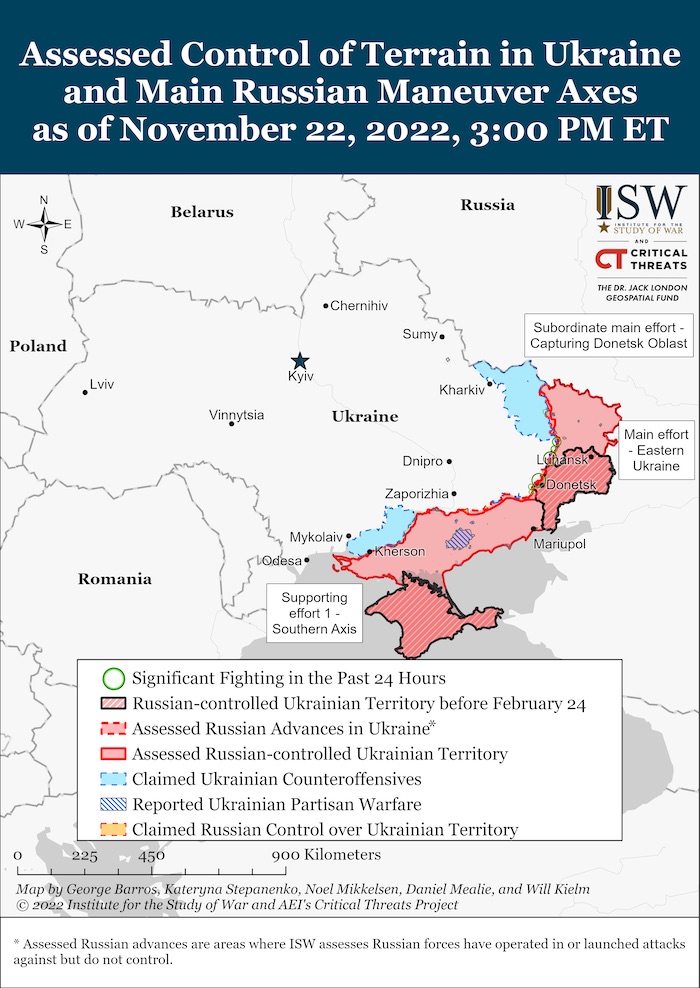
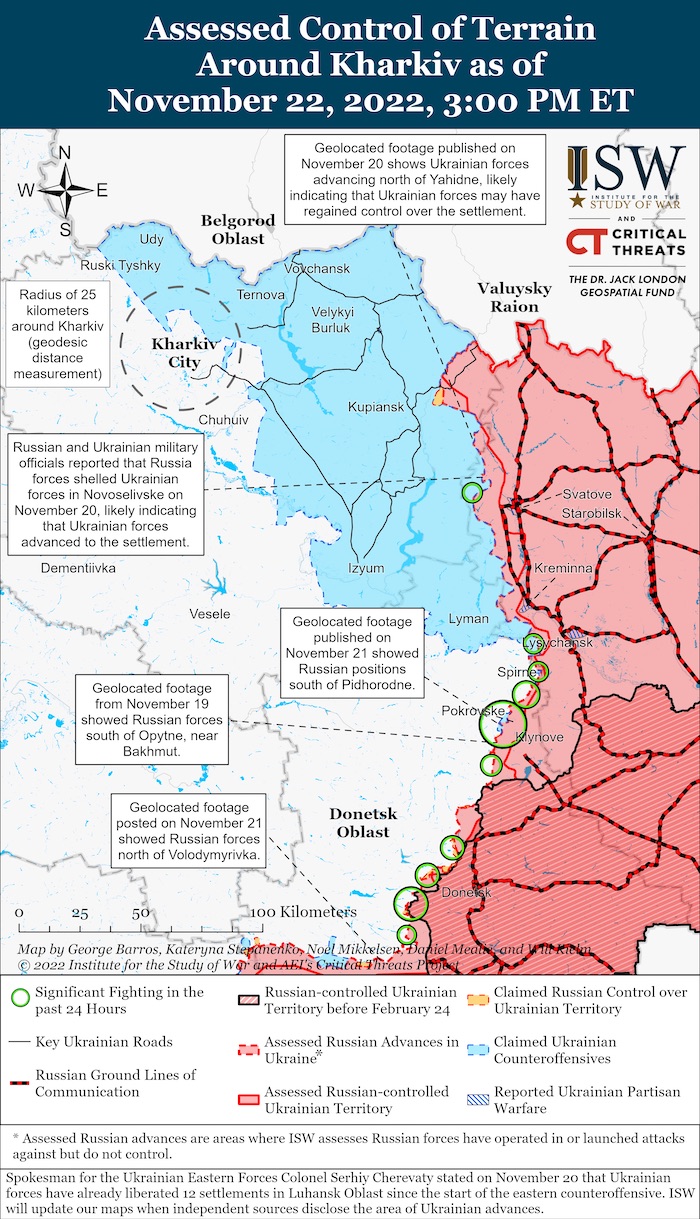

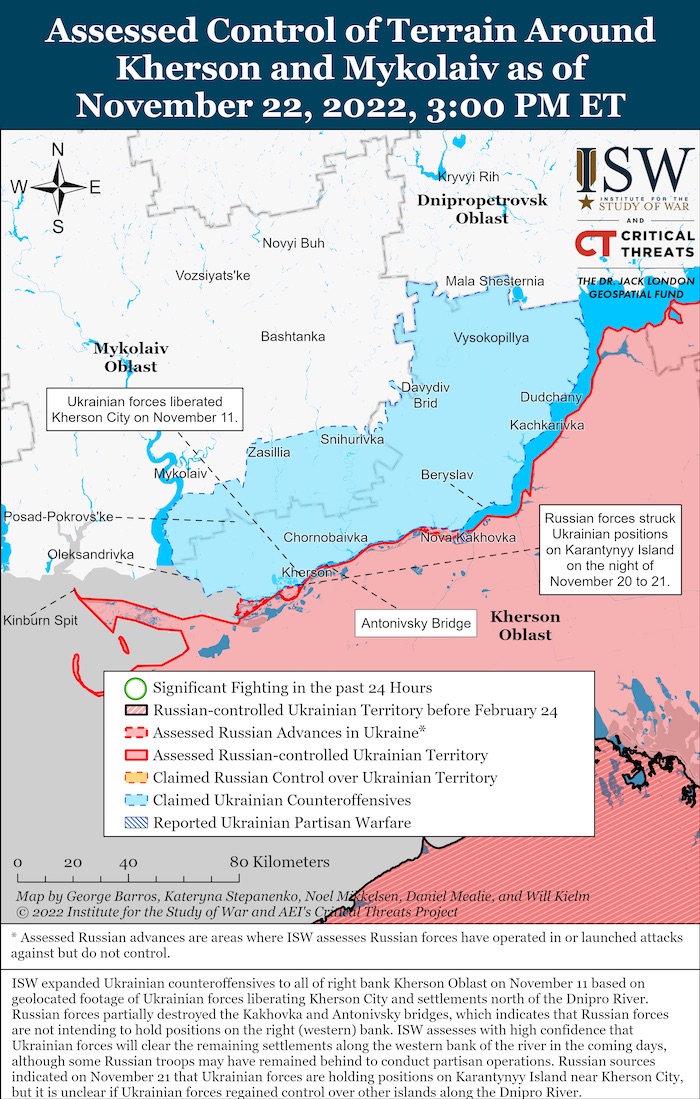
Military Updates

Silent military operation underway on Kinburn split - OperCommand South spox
According to Natalia Humeniuk, control over the spit will secure the grain corridor from the Port of Mykolaiv https://t.co/DvPbJ35UKq pic.twitter.com/xWyTHbP8rG
— Euromaidan Press (@EuromaidanPress) November 22, 2022
Regional Updates
A newborn baby killed in an overnight Russian missile attack on a maternity ward in the Zaporizhzhia Oblast.
A newborn baby killed in overnight Russian missile attack on maternity ward in Vilniansk, Zaporizhzhia region. Those who insist on peace talks with the terrorists should first talk to the mother of this baby. pic.twitter.com/AGLPdN99Hj
— Maria Avdeeva (@maria_avdv) November 23, 2022
In the Kherson Oblast,
one child dead, two injured by a Russian shelling.
2 Ukrainian children died because of russian shelling. One newborn boy was killed in Zaporizhzhya region. Another one was 13 & died after Russian shelling in Kherson region. Two other children are being operated in Kherson in extremely difficult conditions. They are 13 & 14
— Iuliia Mendel (@IuliiaMendel) November 23, 2022
According to British Defence Intelligence, (last 48 hours):
- Since September, Russia has likely launched hundreds of Iranian-manufactured uncrewed aerial vehicles (UAVs) against Ukraine. These have been a mixture of one way attack (OWA) UAVs and more traditional reusable armed systems.
-
Russia has largely used these weapons against tactical military targets and the Ukrainian electricity grid. However, recently Russian commanders likely also wanted Iranian-sourced UAVs to prioritise medical facilities as targets of opportunity, and strike them with guided munitions if identified.
- Russia likely conceived of the UAV campaign to make up for its severe shortage of cruise missiles, but the approach has had limited success. Most UAVs launched have been neutralised.
- No OWA UAVs strikes have been publicly reported since around 17 November 2022. Russia has likely very nearly exhausted its current stock, but will probably seek resupply. Russia can probably procure UAVs from overseas more rapidly than it can manufacture new cruise missiles domestically.
Losses of the Russian army
As of 23 November, the approximate losses of weapons and military equipment of the Russian Armed Forces from the beginning of the war to the present day:
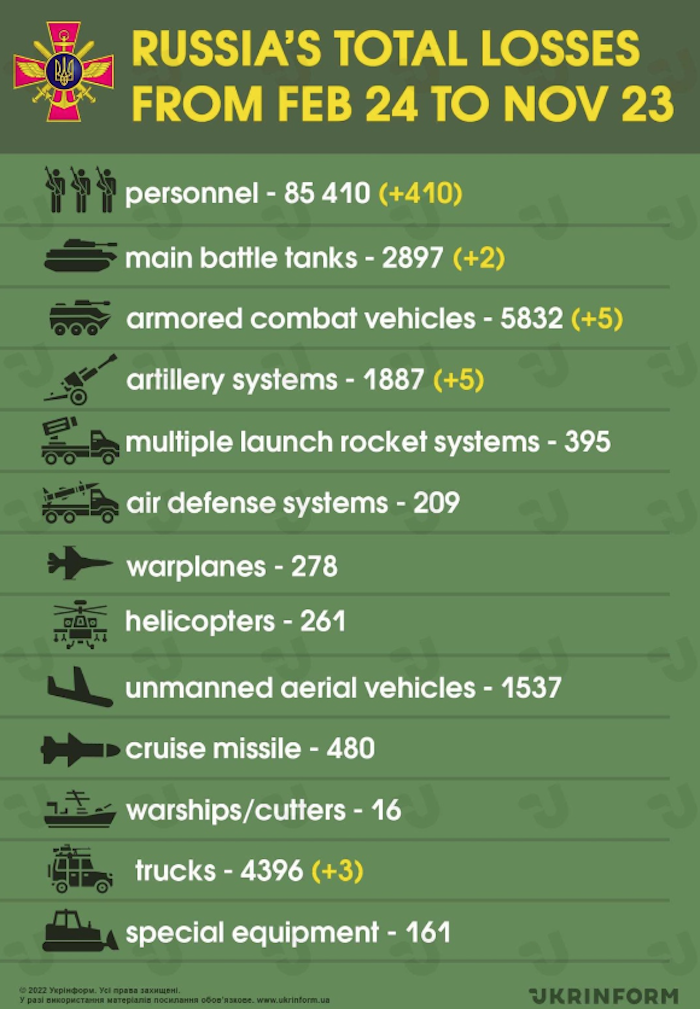
Humanitarian
WHO documented 703 attacks on Ukraine's health infrastructure: millions of lives under threat in Ukraine this winter. The lives of millions will be under threat in Ukraine this winter, the World Health Organization has said, according to BBC. Half of Ukraine’s energy infrastructure is either damaged or destroyed, and 10 million are currently without power, said Dr. Hans Kluge, WHO regional director for Europe. Read more here.
https://twitter.com/EuromaidanPress/status/1595206493992882177
Russians hit the humanitarian aid center killing one, and injuring two in Orikhiv, Zaporizhzhia Oblast – Oblast Head. Read more here.
Environment
️Legal
Ukraine accuses Russia of staging simulated surrender in Makiivka and claims there were no ‘executed POWs’. Ukraine’s Prosecutor General’s Office has initiated proceedings over the incident in Makiivka (Luhansk oblast) in which at least 12 Russian fighters were killed. While Russia is claiming that these were prisoners of war who had surrendered, examination of video footage has led the Luhansk Regional Prosecutor to classify this as the war crime of perfidy, with the Russians having, allegedly, imitated surrender, only for one of the soldiers to open fire on the approaching Ukrainians. Read more here.
Support
The World Bank Group has announced an additional assistance package for Ukraine of $4.5 billion. The total financial support provided to Ukraine by the World Bank reaches $17.8 billion.
Three Ukrainian poets will try to break the consensus among Italians prone to keeping their “equidistance” in the Russian invasion precisely at the time when the new government of Giorgia Meloni faces increasing pressure to lift sanctions on Russiahttps://t.co/Kf89KVdl2K
— Euromaidan Press (@EuromaidanPress) November 22, 2022
New Developments
SBU raids Moscow Patriarchate-controlled Kyiv Pechersk Lavra monastery complex in Ukrainian capital
SBU says it's checking reports on the use of Moscow Patriarchate's church premises for hiding sabotage groups, foreign citizens, storing weapons.https://t.co/cp5ZC7UyFO pic.twitter.com/jy9e2osfcE
— Euromaidan Press (@EuromaidanPress) November 22, 2022
Russian missile strikes on energy infrastructure have left Ukraine reeling from blackouts. Odesa has spent several days without electricity at all. @ZarinaZabrisky describes how it is to live and work in a city without power for days in a rowhttps://t.co/r3Jd3wfxfM
— Euromaidan Press (@EuromaidanPress) November 22, 2022
Assessment
- On the war.
The Institute for the Study of War has made the following assessment as of 22 November, 2022:
The Kremlin appears to be setting information conditions for a false-flag attack in Belgorod Oblast, Russia, likely in an effort to regain public support for the war in Ukraine. Kremlin propagandists have begun hypothesizing that Ukrainian forces seek to invade Belgorod Oblast, and other Russian sources noted that Russian forces need to regain control over Kupiansk, Kharkiv Oblast, to minimize the threat of a Ukrainian attack.[1] These claims have long circulated within the milblogger community, which had criticized the Russian military command for abandoning buffer positions in Vovchansk in northeastern Kharkiv Oblast following the Russian withdrawal from the region in September.[2] Russian milbloggers have also intensified their calls for Russia to regain liberated territories in Kharkiv Oblast on November 22, stating that such preemptive measures will stop Ukrainians from carrying out assault operations in the Kupiansk and Vovchansk directions.[3] Belgorod Oblast Governor Vyacheslav Gladkov also published footage showcasing the construction of the Zasechnaya Line fortifications on the Ukraine-Belgorod Oblast border.[4] Wagner Group financier Yevgeniy Prigozhin clarified that Wagner is building the Zasechnaya Line after having changed its name from Wagner Line because “many people in [Russia] do not like the activity of private military company Wagner.”[5] Private military companies are illegal in Russia.
Russian claims of an imminent Ukrainian attack on Belgorod Oblast are absurd and only aim to scare the general public to support the war. Ukraine has no strategic interest in invading Russia and no ability to do so at such a scale. Ukrainian forces are continuing to liberate occupied settlements in western Luhansk Oblast following their victory in northern Kharkiv Oblast.[6] Support for Russia’s nonsensical invasion is declining among Russian residents of border regions and the rest of the country as a result of mobilization and military failures. Russian opposition outlets reported that relatives of mobilized men have ignited protests in 15 Russian regions since the end of October, with the most notable ones taking place in regions bordering Ukraine.[7] A Russian opposition outlet, Meduza, citing two unnamed sources close to the Kremlin, reported that the Russian Presidential Administration carried out an internal survey in different regions where many expressed apathy toward the war.[8] While ISW cannot independently verify Meduza’s report, emerging calls for demobilization among relatives of mobilized men suggest that Russian propaganda is ineffective in countering the real-life consequences of the war on the society.[9]
These ridiculous speculations about a fantastical Ukrainian invasion of Russia may also be part of the Kremlin’s effort to acknowledge and appease the Russian pro-war nationalist community. Russian milbloggers have repeatedly accused the Kremlin and the Russian Ministry of Defense (MoD) of failing to defend Russia, including the newly annexed territories.[10] The Kremlin, however, will unlikely be able to reinvade Kharkiv Oblast as demanded by these nationalist figures.
Prigozhin is also using fearmongering about a fictitious Ukrainian invasion threat and the construction of the Zasechnaya Line to solidify his power in Russian border regions and Russia. Belgorod Oblast officials previously halted the construction of the Wagner Line, and the line’s rebranding alongside other Prigozhin projects in St. Petersburg and Kursk Oblast signifies that he will continue to establish himself in Russia while ostensibly supporting Russian President Vladimir Putin’s war.[11]
The Russian military has significantly depleted its arsenal of high-precision missiles but will likely still be able to attack Ukrainian critical infrastructure at scale in the near term. Ukrainian Minister of Defense Oleksii Reznikov released figures on November 22 detailing that the Russian military has only 119 Iskanders missiles, 13 percent of its initial February 2022 arsenal.[12] Reznikov’s figures also show that Russian forces have significantly depleted other key high-precision weapons systems with only 229 Kalibr missiles (45 percent of the initial February 2022 stock), 150 Kh-155 missiles (50 percent of the initial February 2022 stock), and 120 Kh-22/32 missiles (32 percent of the initial February 2022 stock) remaining. Reznikov’s figures show that Russian forces have substantially depleted stocks of 3M-55 “Onyx”, S-300, Kh-101, Kh-35, and Kh-47M2 Kinzhal missiles as well.[13]
Ukrenergo head Volodymyr Kudrytsky stated on November 22 that Russian forces have damaged almost all thermal power plants, large hydropower plants, and Ukrenergo hub substations in Ukraine.[14] Ukrainian Prime Minister Denys Shmyhal stated on November 18 that more than half of the Ukrainian power grid has failed as a result of Russian missile strikes.[15] DTEK CEO Maxim Tymchenko urged Ukrainians to leave the country, if possible, on November 19 to ease demand on the Ukrainian power grid, and YASNO CEO Serhiy Kovalenko stated on November 21 that regular power outages will likely last at least until the end of March 2023.[16] Russian forces will likely be able to continue to reduce the overall capacity of Ukrainian critical infrastructure in the near term given the current state of the Ukrainian power grid. The depletion of the Russian military’s high-precision missile arsenal will likely prevent it from conducting missile strikes at a high pace, however. ISW continues to assess that the Russian military will fail to achieve its goal of degrading the Ukrainian will to fight through its coordinated campaign against Ukrainian infrastructure.
The Russian military is likely experiencing problems in replenishing its arsenal of high-precision weapons systems. Ukrainian Air Force Command spokesperson Yuriy Ignat stated on November 21 that Russia is experiencing problems with the supply of Iranian missiles to the Russian Federation.[17] Ignat speculated that diplomatic resources, negotiations, or other countries’ influence may have impacted Iran’s ability or willingness to supply Russia with ballistic missiles.[18] ISW has previously assessed that Russia is increasingly dependent on Iran for the provision of high-precision weapons systems.[19] Ignat also reported that Russia lacks the necessary components produced abroad to support the manufacturing of the number of missiles it needs for its campaign against Ukrainian infrastructure.[20] Reznikov stated that Russia manufactured 120 Kalibr and Kh-101 missiles and 360 Kh-35 missiles since February 2022, allowing the Russian military to partially offset the heavy use of these weapons systems in massive strikes on Ukrainian infrastructure.[21] Russia likely significantly strained the existing capacity of its military industry in producing these missiles.
Belarusian Prime Minister Roman Golovchenko has traveled to Iran to discuss economic cooperation and possibly security ties. Golovchenko met with Iranian First Vice President Mohammad Mokhber and will likely meet Iranian President Ebrahim Raisi and other officials in the coming days.[22] Golovchenko’s visit to Tehran follows the Ukrainian Main Directorate of Intelligence reporting on November 17 that Iran may help Belarus produce artillery shells.[23]
Russian military movements suggest that Russian forces are likely reinforcing positions in eastern Zaporizhzhia and western Donetsk oblasts. The Ukrainian General Staff reported on November 22 that Chechen and Wagner Group formations deployed to Debaltseve, Donetsk Oblast, and that Russian forces are regrouping individual units in the area of Molchansk, Zaporizhzhia Oblast (just northeast of Melitopol).[24] Social media sources posted images on November 21 showing Russian trucks and vehicles in Melitopol moving from the south to the north throughout November.[25] Geolocated images show Russian military vehicles moving through Bezimenne and Mariupol in Donetsk Oblast carrying a notable amount of military equipment.[26] ISW has previously assessed that Russian forces have begun reinforcing positions in eastern Zaporizhzhia Oblast with personnel from Kherson Oblast and mobilized personnel.[27] Russian forces may be reinforcing positions in eastern Zaporizhzhia and western Donetsk oblasts to prepare for perceived threats of future Ukrainian operations or to support the effort to restart the Donetsk offensive.
Key Takeaways
- The Kremlin may be setting information conditions for a false-flag attack in Belgorod Oblast.
- The Russian military has significantly depleted its arsenal of high-precision missiles but will likely still threaten Ukrainian infrastructure.
- The Russian military is likely struggling to replenish its arsenal of high-precision weapons systems.
- The Belarusian prime minister traveled to Iran to discuss economic cooperation and possible security ties.
- Russian military movements suggest that Russian forces are likely reinforcing positions in eastern Zaporizhzhia and western Donetsk oblasts.
- Russian sources claimed that Ukrainian forces continued counteroffensive operations along the Svatove-Kreminna line.
- Russian forces continued offensive operations around Bakhmut and Avdiivka.
- Crimean occupation officials demonstrated heightened unease—likely over Ukrainian strikes on Russian ground lines of communication (GLOCs) in the peninsula and ongoing military operations on the Kinburn Spit.
- The Kremlin continues to deflect concerns about mobilization onto the Russian Ministry of Defense (MoD).
- Russian sources continue to tout the forced adoption of Ukrainian children into Russian families.

